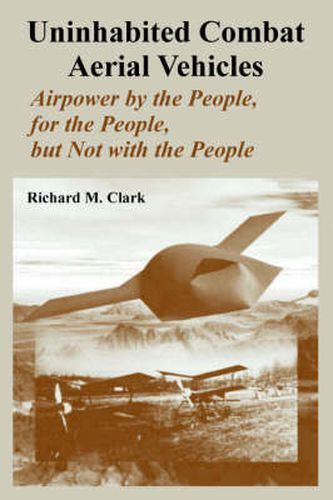Uninhabited Combat Aerial Vehicles: Airpower by the People, for the People, but Not with the People
Richard M Clark

Uninhabited Combat Aerial Vehicles: Airpower by the People, for the People, but Not with the People
Richard M Clark
This title is printed to order. This book may have been self-published. If so, we cannot guarantee the quality of the content. In the main most books will have gone through the editing process however some may not. We therefore suggest that you be aware of this before ordering this book. If in doubt check either the author or publisher’s details as we are unable to accept any returns unless they are faulty. Please contact us if you have any questions.
In one form or another, unmanned aerial vehicles (UAV) have been employed for over 2,000 years. Lt Col Richard M. Clark’s Uninhabited Combat Aerial Vehicles: Airpower by the People, For the People, But Not with the People, draws on that long history to gauge what the future may hold for uninhabited combat aerial vehicles (UCAV). The United States (US) Air Force’s experience with UCAVs dates back to World War I and the US Army Air Service’s order for 25 Kettering Bugs, explosive-laden unmanned minibiplanes. Over the next 60 years, the Air Force continued to experiment with-and periodically employ-UAVs/UCAVs in peace and war. Operational results were decidedly mixed. The Air Force abandoned UCAV development in the aftermath of the Vietnam War, but by the 1990s there was a marked resurgence of interest in UCAVs as a means of doing more with less while reducing combat risks to pilots. Given the problematic history of UAVs/UCAVs, knowledge of past experience could prove beneficial to the current generation of UCAV developers and planners. To that end, Colonel Clark examines technological obstacles that have handicapped UCAVs historically and which could continue to impede their future evolution. He then turns to more contemporary organizational and cultural issues that might hinder integration of UCAVs into the force. Clark concludes his study by proposing answers to two fundamental questions: (1) What are the major obstacles to UCAVs achieving meaningful operational status in the Air Force, and (2) Can those obstacles be overcome? Originally written as a master’s thesis for Air University’s School of Advanced Airpower Studies (SAAS), Uninhabited Combat Aerial Vehicles won the 1999 Air Force Armament Museum Foundation Prize as the best SAAS thesis on technology and aerospace power. The College of Aerospace Doctrine, Research and Education is pleased to make this timely study available to the Air Force and beyond. JAMES R. W. TITUS Dean of Research Air University
This item is not currently in-stock. It can be ordered online and is expected to ship in 7-14 days
Our stock data is updated periodically, and availability may change throughout the day for in-demand items. Please call the relevant shop for the most current stock information. Prices are subject to change without notice.
Sign in or become a Readings Member to add this title to a wishlist.


